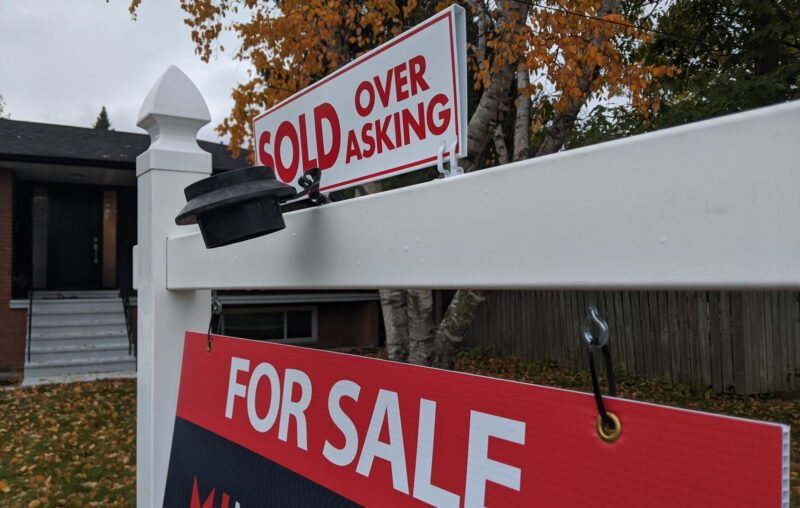No Place to Lay Your Head: How Economic Policy Makes Housing Unaffordable for Young Working Families

When it comes to the decision whether to rent or own, most of our parents gave us counsel that went something like this: (1) move out (!), (2) rent something inexpensive while you save until you can afford a downpayment on a home, and then (3) finance a home because you are investing in real estate – rather than “throwing away” rent money every month.
Yet in today’s real estate market – whether in Southwest Florida, Alabama, or Western Massachusetts – all three of those pieces of advice are nearly impossible for young working families to follow. And whether it’s the rental market or the market for single-family homes, wrong-headed economic policy – federal, state, and local – is to blame.
And it’s bad. While most Americans believe that moving out of your parents’ home is an important rite of passage, recent Pew data indicate that a stunning 37 percent of men aged 25-29 now share a residence with an older relative. And in many cases, both males and females are moving back in with their parents for financial reasons. They just can’t find a way to make the money work.
Now a skeptic might suggest that young people are moving back home because they don’t work hard, can’t stick to a budget, or don’t possess the fortitude necessary to face the world head on. But rental price data suggests otherwise.
The US Department of Housing and Urban Development (HUD) refers to households as being “housing-cost-burdened” when they spend more than 30 percent of their monthly household income on rent or a mortgage, plus other housing needs like utilities. Such cost-burdened families frequently have difficulty paying for other essentials like food, clothing, transportation, or medical care. And renters are much more likely to be housing-cost burdened than mortgage holders.
The latest national data (May 2023) from the Waller-Weeks-Johnson Rental Index highlight the financial hardship faced by young households who either rent or want to. In May 2023, the average national rent was $2,048.36. This represents an 8.11 percent premium above the rent one would expect based on historical growth rate trends, and also represents a 4.79 percent increase in the past year alone. The index also estimates the annual income required for an average household to avoid being “rent burdened” according to the HUD definition, and in May 2023 that number for the US was a whopping $81,934. Yet the most recent Census Bureau estimate of US annual household income (though with a two-year lag) was roughly just $70,000. Clearly conditions throughout many of the nation’s rental markets make it very challenging for young households to find housing at a price that aligns with their budget constraints.
In addition, because the cost of utilities can vary so much from city to city, the Waller-Weeks-Johnson index omits utility costs completely from its estimated monthly cost of housing. This means that rental markets are even more burdened than the index indicates, and that an average household needs even more annual income to avoid being rent-burdened than the May 2023 estimate of $81,934.
But why? Why is all housing so unaffordable for many? And why isn’t it limited to either rent prices or home prices?
A fundamental reason that prices of all housing – apartments, condos, townhouses, and single-family dwellings – move up and down together is because buying a home and renting are the two alternatives most of us face. Economists refer to these as “substitute goods.” Examples abound. In one recent instance, pandemic-driven microchip supply-chain issues reduced the supply of new cars – resulting in a surge in prices of not only new cars but also their closest substitute: used cars. So when it comes to housing, high prices – or high mortgage rates – in residential real estate will drive families into the rental market, driving up rents. Conversely, high rents can drive families into the homebuying market, driving up home prices. In short, housing costs move up and down together – regardless of which market changes first.
But none of this resolves the fundamental question of why all housing costs seem so high. Nor why price drops are ephemeral, while increases quickly become the new normal.
The answer is two-fold. First, much housing policy – often born of good intentions – results in what we like to refer to as “artificial scarcity.” Now we all encounter artificial scarcity most often when we deal with monopolies. In fact, that’s the entire point of being a monopolist. Because you face no competition, you can get away with producing less of a good or service than we’d see in a more competitive market. That’s artificial scarcity. And when you produce less, you can charge more.
This is why incumbent monopolists and wannabe monopolists alike work so hard to pursue economic regulations that guarantee their firms reap the profits of artificial scarcity for as long as possible. The best guarantee of ongoing monopoly power is to get politicians to make it illegal to compete with you. Economists refer to the costly efforts firms incur to lobby politicians in this way as “rent-seeking” behavior.
There’s also artificial scarcity in housing markets, but in that case it’s the planners themselves who put housing in such short supply – and at consequent high prices.
For starters, most municipalities around the country use residential zoning, a process that restricts land use in one “zone” to a few limited uses. For example, if a neighborhood is “zoned” for only single-family residential dwellings, then it’s unlawful to build an apartment building or an auto repair shop in that zone. You can see already that such zoning ordinances create an artificial shortage of apartment buildings where there doesn’t need to be a shortage. And when there is artificial scarcity, higher prices follow.
Defenders of residential zoning generally proceed along two lines. First, we ourselves have heard residents defend such restrictive policies because they have been arrived at via the democratic process. That is, if current residents living in single-family neighborhoods wish to vote to keep it that way, then it’s their democratic right to do so. After all, who could object to policies decided by democracy?
But just because policy is arrived at by voting doesn’t mean it will be good policy. It’s an extreme example, but we used to tolerate slavery in the United States – a product, at the time, of representative democracy. But that policy was wrongheaded for all kinds of reasons. Or to take a ridiculous example, I am pretty sure there are sufficient votes to ban bowties, via popular vote, from men’s fashion if we cared to. But that would be a silly policy to enact because it would interfere with the ability of individuals to freely choose their neckwear.
The other argument that defenders of residential zoning will make is that it keeps neighborhoods “nice.” We have personally heard people say things like, “nobody wants a church near a school near a restaurant near an auto body shop.” But this argument overlooks significant challenges. First, throughout most of human history, including much of US history, we all worked and played and worshiped and shopped within the same neighborhood. The strip mall, the subdivision, and the industrial park are twentieth-century inventions, and we now drive to all of the places we used to walk to within our neighborhoods. And in most cases, the reason we do everything in different zones now is because of zoning ordinances that made it so – not because the subdivision and the industrial park spontaneously emerged as the product of a free society.
Any restriction of any use of any productive resource – whether it be land, labor, capital, or entrepreneurship – will necessarily limit and frustrate its productive potential.
Which brings us back to artificial scarcity. If young working families need more housing, the market should be free to deliver what they want and need. Instead we limit the places where new apartments can be constructed. If you ever wonder why the new apartment building goes up behind your local Walmart and not someplace more convenient for its residents, blame zoning.
Even where single-family dwellings are concerned, we create artificial scarcity. Most municipalities dictate minimum lot sizes, minimum distances from the street, and minimum distances from neighbors’ homes. Such policies artificially restrict the number of residents to something smaller than it needs to be. It’s all democratic, but it restricts the options for working families looking for a place they can afford that is also convenient to their workplace as well as the schools they want their kids to be able to attend.
But what about the other reason for a lack of affordable housing? We mentioned “artificial scarcity” through zoning, minimum lot sizes, and “setbacks” (minimum distances from your neighbors or the street). But what else gets in the way of affordable housing for young working families?
The other answer lies in the Fed’s activist management of interest rates. Interest rates — all of them — are arguably the most important prices in a market economy. They should help households figure out how much to save and over what time horizons, and they should facilitate sensible borrowing and investing by firms. But rather than allowing interest rates to coordinate such plans, the Fed commandeers interest rates in an effort to deliver on its only two responsibilities: “maximum employment” and “price stability.” As a consequence, interest rates cannot convey accurately to developers how much to borrow and when, and they cannot do the same for potential homebuyers either.
In recent months, home prices have softened slightly since the worst of the pandemic, which sounds like good news. But at the same time, home mortgage interest rates have more than doubled. And the real monthly cost of your house is your mortgage payment – calculated using both the sale price of the house and the interest rate you locked in. While sale prices for single-family homes have softened, it’s difficult to claim that housing costs overall have moderated in any serious way.
It’s often said that less is more. And, in this case, less housing regulation and less intervention by the Fed could lead to more of what we claim to want: affordable housing for all, located in the most socially beneficial places possible.












